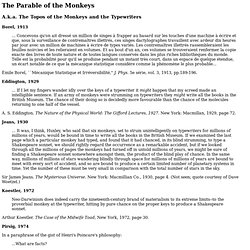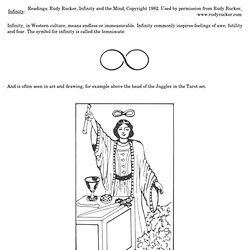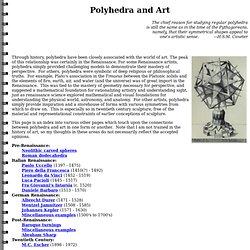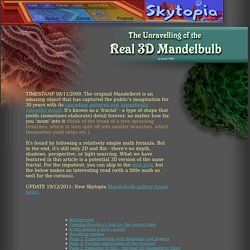

Infinite monkey theorem. The infinite monkey theorem states that a monkey hitting keys at random on a typewriter keyboard for an infinite amount of time will almost surely type a given text, such as the complete works of William Shakespeare. In this context, "almost surely" is a mathematical term with a precise meaning, and the "monkey" is not an actual monkey, but a metaphor for an abstract device that produces an endless random sequence of letters and symbols. One of the earliest instances of the use of the "monkey metaphor" is that of French mathematician Émile Borel in 1913,[1] but the earliest instance may be even earlier. The relevance of the theorem is questionable—the probability of a universe full of monkeys typing a complete work such as Shakespeare's Hamlet is so tiny that the chance of it occurring during a period of time hundreds of thousands of orders of magnitude longer than the age of the universe is extremely low (but technically not zero).
Solution[edit] Direct proof[edit] Infinite strings[edit] Parable of the Monkeys. A.k.a.

The Topos of the Monkeys and the Typewriters Borel, 1913 ... Concevons qu'on ait dressé un million de singes à frapper au hasard sur les touches d'une machine à écrire et que, sous la surveillance de contremaîtres illettrés, ces singes dactylographes travaillent avec ardeur dix heures par jour avec un million de machines à écrire de types variés. Les contremaîtres illettrés rassembleraient les feuilles noircies et les relieraient en volumes.
Émile Borel, ``Mécanique Statistique et Irréversibilité,'' J. Eddington, 1929 ... Infinite. Infinity, in Western culture, means endless or immeasurable.

Infinity commonly inspires feelings of awe, futility and fear. Polyhedra and Art. The chief reason for studying regular polyhedra.

The Pleasures of Mathematics. The greatest pleasures of mathematics and science are in understanding. Here is an example. Much too often science and mathematics are presented as Gee Whiz, or as the ability to perform calculations, or to answer Jeopardy-style questions, or even to feel superior to those of lesser knowledge. The enjoyment of these things soon palls and becomes stale. The real fascination is in understanding the world, not just describing it. As one example, consider the five Platonic solids, the convex regular polyhedra. If you have not thought about proving that there are only five regular convex polyhedra, read on and see if you do not think it is satisfying to know how. Polyhedra Index Page. What's new For regular visitors, here is a handy reference to what has changed over the last year or so. 29 May 2011.

Ditela, polytopes and dyads A new name for closed line segments completes the pantheon of names for polytopes - updated to 9 dimensions and other minor revisions/corrections. 27 March 2011. It's a long way to the stars or, The sorry state of polyhedron theory today - updated with some more and better answers, and a sneak preview of my topological journey. 30 October 2010. 4 Mar 2008. 16 Feb 2008. 2 Feb 2008.
Higher Dimensions Introduction - Site Map. Uniform Polychora. Welcome to my new and improved polychoron web site. Uniform polychoron count still stands at 1849 plus many fissaries, last four discovered are ondip, gondip, sidtindip, and gidtindip. Most of the graphics was done using Pov-Ray. Last updated April 22, 2014. 2014 April 22 - Added new definitions in glossary, finished fixing transparancy issues in the PNG files. Added Pizza Graphs of the Jewel Regiments page. 2013 September 12 - New polyteron of the day site. 2012 August 12 - Small corrections to Category B and Scaliform sector. 2012 June 10 - I got a bit carried away, this is by far the largest update to this site ever!!!
Previous Updates 2010 October 25 - New high res pics for categories 1-4 with clickable picture tables. 2009 February 8 - Added Polyteron website with three categories (1,2, and 3) to start it off. 2008 August 23 - Added some polychoron pics in 3D, also added categories A, B, 13 and 19. Mandelbulb: The Unravelling of the Real 3D Mandelbrot Fractal. Opening Pandora's Box For the Second Time ur story starts with a guy named Rudy Rucker, an American mathematician, computer scientist and science fiction author (and in fact one of the founders of the cyberpunk science-fiction movement).

Around 20 years ago, along with other approaches, he first imagined the concept behind the potential 3D Mandelbulb (barring a small mistake in the formula, which nevertheless still can produce very interesting results - see later), and also wrote a short story about the 3D Mandelbrot in 1987 entitled "As Above, So Below" (also see his blog entry and notebook). Back then of course, the hardware was barely up to the task of rendering the 2D Mandelbrot, let alone the 3D version - which would require billions of calculations to see the results, making research in the area a painstaking process to say the least.
So the idea slumbered for 20 years until around 2007. Full size shown here. Is this merely a fool's quest? Mandelbulb (order 8) WOW! Resulting renders.